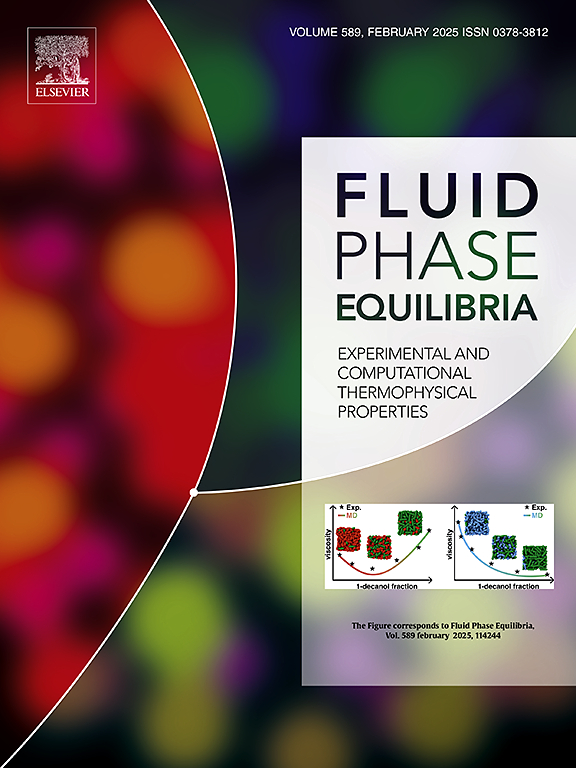Experimental and theoretical quantification of phase behaviour for solvents/water/heavy oil systems with the PC-SAFT equation of state
IF 2.7
3区 工程技术
Q3 CHEMISTRY, PHYSICAL
引用次数: 0
Abstract
In this work, a new framework has been proposed to quantify phase behaviour of solvents-water-heavy oil systems based on the perturbed-chain statistical associating fluid theory equation of state (PC-SAFT EOS) and then compared it with the cubic EOSs (e.g., PR EOS). Experimentally, constant composition expansion (CCE) tests were meticulously conducted to measure saturation pressure (), phase volume, and phase compositions for CO2/heavy oil, N2/heavy oil, and dimethyl ether (DME)/heavy oil systems with and without water at pressures up to 20 MPa and temperatures up to 433.2 K. Theoretically, a PC-SAFT EOS framework incorporated temperature-independent binary interaction parameters (BIPs) is employed to reproduce the measured and other physical properties of the aforementioned systems. Addition of water into each of the aforementioned systems is found to increase its compared to the systems without water. By characterizing heavy oil as four pseudocomponents, density of the aforementioned systems can be accurately predicted with the root-mean-squared relative error (RMSRE) of 1.84%. Then, the BIPs for each binary pair of the aforementioned systems are obtained by minimizing the deviation between the experimentally measured and the corresponding calculated values. Compared with the modified PR EOS, the proposed framework shows its superior performance with an RMSRE of 2.93% for the predicted of the aforementioned systems.
用PC-SAFT状态方程对溶剂/水/重油体系相行为进行实验和理论量化
本文提出了一个基于摄动链统计关联流体理论状态方程(PC-SAFT EOS)的新框架来量化溶剂-水-重油体系的相行为,并将其与立方方程(如PR EOS)进行了比较。实验中,在压力高达20 MPa,温度高达433.2 K的条件下,对CO2/重油、N2/重油和二甲醚(DME)/重油体系进行了精确的恒成分膨胀(CCE)测试,以测量有水和无水的饱和压力(Psat)、相体积和相组成。理论上,PC-SAFT EOS框架采用了温度无关的二元相互作用参数(BIPs)来重现测量的Psat和上述系统的其他物理性质。与没有水的系统相比,在上述系统中加入水可以增加其Psat。通过将稠油表征为4个伪组分,可以准确预测上述体系的密度,均方根相对误差(RMSRE)为1.84%。然后,通过最小化实验测量的Psat与相应计算值之间的偏差,获得上述系统的每个二进制对的bip。与改进的PR - EOS相比,该框架对上述系统的预测Psat的RMSRE为2.93%,显示出优越的性能。
本文章由计算机程序翻译,如有差异,请以英文原文为准。
求助全文
约1分钟内获得全文
求助全文
来源期刊

Fluid Phase Equilibria
工程技术-工程:化工
CiteScore
5.30
自引率
15.40%
发文量
223
审稿时长
53 days
期刊介绍:
Fluid Phase Equilibria publishes high-quality papers dealing with experimental, theoretical, and applied research related to equilibrium and transport properties of fluids, solids, and interfaces. Subjects of interest include physical/phase and chemical equilibria; equilibrium and nonequilibrium thermophysical properties; fundamental thermodynamic relations; and stability. The systems central to the journal include pure substances and mixtures of organic and inorganic materials, including polymers, biochemicals, and surfactants with sufficient characterization of composition and purity for the results to be reproduced. Alloys are of interest only when thermodynamic studies are included, purely material studies will not be considered. In all cases, authors are expected to provide physical or chemical interpretations of the results.
Experimental research can include measurements under all conditions of temperature, pressure, and composition, including critical and supercritical. Measurements are to be associated with systems and conditions of fundamental or applied interest, and may not be only a collection of routine data, such as physical property or solubility measurements at limited pressures and temperatures close to ambient, or surfactant studies focussed strictly on micellisation or micelle structure. Papers reporting common data must be accompanied by new physical insights and/or contemporary or new theory or techniques.
 求助内容:
求助内容: 应助结果提醒方式:
应助结果提醒方式:


